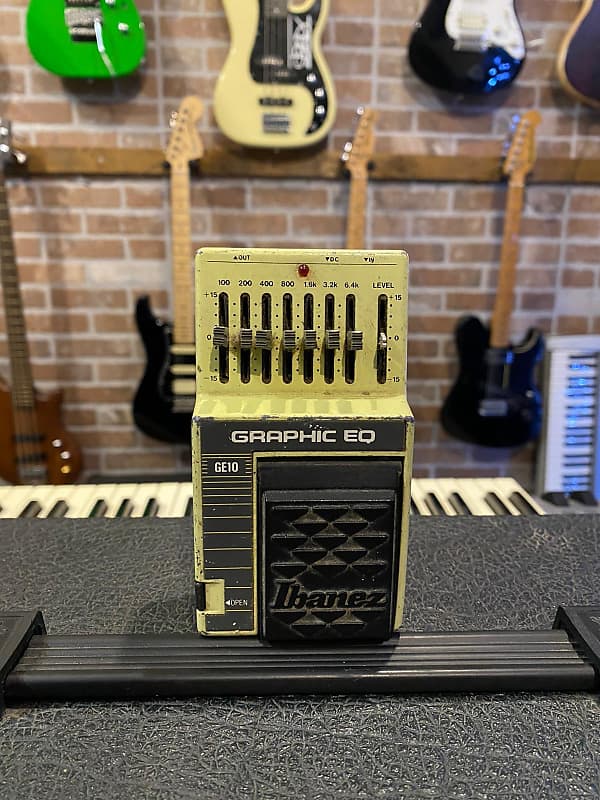If you had an Unicorn Account you could see a chart with the price development of this module and the average price asked for this module.
VERY GOOD CONDITION!The Ibanez GE10 Graphic Equalizer controls the seven octave ranges between 100Hz and 6.4kHz with a +/- 15dB equalization adjustment for each octave. There is also a master gain control that provides an overall +/- 15dB variation in the output level without affecting the filter settings.The GE10 is especially useful as a device to alter the overall tone, but it also has other applications. By manipulating the 3.2kHz and 6.4kHz filters, troublesome feedback squeals can be reduced or eliminated. Additionally, the GE10 can be used as a gain booster by increasing the level control.PRODUCT SPECIFICATIONS:A graphic equalizer can be a very useful tool for a guitarist who needs versatility in basic tones. The GE10 is less of an effect and more of a "tone shaper." The seven bands or frequency ranges covered by the GE10 are the most important for guitarists. Each band can be boosted or cut by up to 15dB (decibels). For example, a 10dB boost at 200Hz would give any guitar a much bass-heavy sound by increasing the volume of the low notes and subharmonics.100Hz and below are very low tones that, when boosted, add a rumbling effect, similar to the resonance of a large speaker cabinet. Cutting this range can help clear up a muddy sound or reduce hum and noise from poor A.C. lines or single-coil pickups.200Hz, as in the example, can influence the overall bass characteristics of the sound. Reducing 200Hz can emphasize a boost in the surrounding areas of 100Hz or 400Hz.400Hz is where the warmth of a guitar sound can be emphasized with a slight boost: particularly useful after a distortion device to simulate American tube amps with 12" speakers in open-back cabinets. Cutting 400Hz can remove the midrange characteristics that are often undesirable in acoustic-electric guitars.800Hz, like 400Hz, can be used to add character to a distorted lead sound. A slight boost at both 800Hz and 400Hz can fatten up single-coil pickups, simulating the sound of a humbucker (try also cutting higher frequencies).1.6kHz can be boosted for increased presence and clarity. An extreme boost can emphasize pick attack and amplifier feedback characteristics, while a slight cut at 1.6kHz can smooth out a rhythm sound.3.2kHz boosted adds bite and brilliance, while 6.4kHz handles the "sizzle" or "sparkle." A guitar with humbuckers set in the center pickup position with both 3.2kHz and 6.4kHz boosted can sound like a single-coil guitar.Please be noted this instrument is USED not new. Please send message for more detail information of the condition. Before purchasing, please contact us to agree on the exact shipping cost, based on the buyer's location.WE TAKE CARE OF YOUR INSTRUMENT FROM PURCHASE TO DELIVERY!All the items we sell have been checked and adjusted for playability. The pictures in the listings are of the actual item for sale, so please take a look to get an idea of the cosmetic condition. As these are used instruments, they may or may not have some scratches or finish wear.Please note: Revintage will not accept returns or refunds for dents, scratches, or cosmetic wear that were originally detailed in the pictures or description. Thank you for your understanding.If you buy outside of the EU, you may be required to pay duty, tax and import fee when receiving your items in your country. You must pay all these duty, tax and fee as receiver/importer and we do not cover any of them.

This offer was fetched from reverb.com. You cannot contact the seller via ModularGrid. You have to visit their site.
Look up onDisclaimer: Modules listed for sale on the ModularGrid Marketplace are offered explicitly by their respective owners. ModularGrid is not affiliated to the sellers and takes no legal responsibility in any transaction.
The internet is a rough place and fraudulent behavior can occur. If you are concerned about dealing with strangers consider buying your module at an authorized dealer.